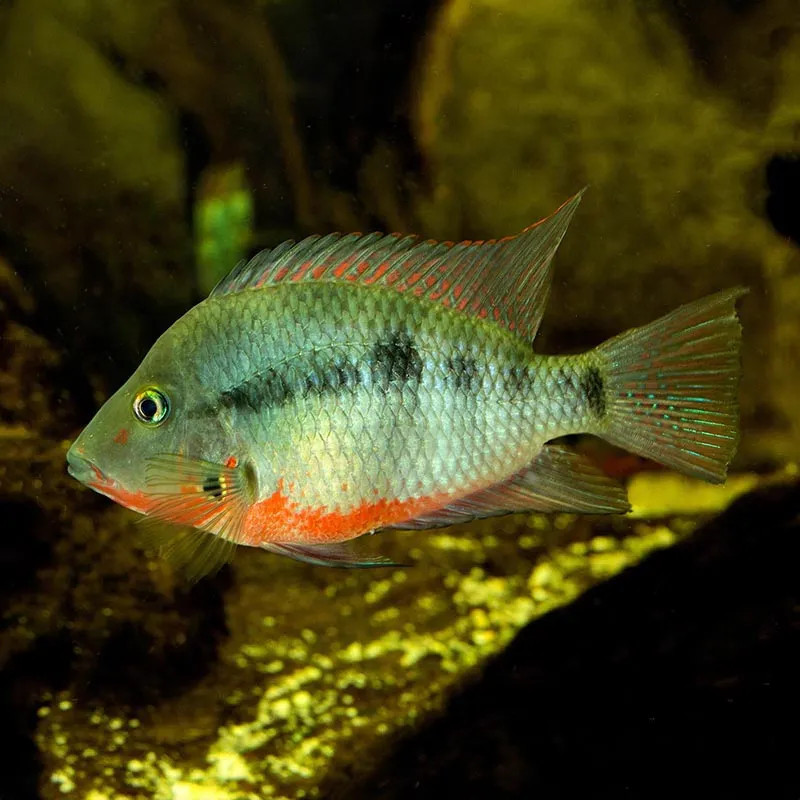Stocks Available
DWARF AGASSIZII FLAME RED
SKU:118878
APISTOGRAMMA AGASSIZII
2.5 M

Stock Available
Introduction: Species: Thorichthys meeki Common Names: Firemouth Cichlid, Firemouth Natural Habitat: Native to the freshwater rivers and lakes of Central America, particularly in Nicaragua and Costa Rica, the Firemouth Cichlid typically inhabits shallow waters with plenty of vegetation and rocky substrates. Physical Characteristics: Appearance: The Firemouth Cichlid is known for its vibrant coloration, particularly its bright orange to red-orange hue on the throat and lower jaw, resembling flames. The body is elongated and slightly laterally compressed, with a base color that ranges from bluish to gray. It also features distinctive dark vertical stripes along its sides. Size: Grows to about 4-6 inches (10-15 cm) in length. Lifespan: Typically lives for 5-8 years with proper care. Habitat Requirements: Tank Size: A minimum of 30 gallons is recommended for a single Firemouth or a pair; larger tanks are preferred to provide adequate swimming space. Water Conditions: Temperature: 75-82°F (24-28°C). pH: 6.5-8.0 (neutral to slightly alkaline). Hardness: Soft to moderately hard water (5-15 dGH). Aquascaping: Provide a well-structured aquarium with plenty of hiding spots using rocks, caves, and live plants to create territories, mimicking their natural habitat. Diet: Primary Diet: Omnivorous; in the wild, they feed on a variety of foods, including small invertebrates, crustaceans, and plant matter. Supplemental Feeding: In captivity, offer high-quality pellets or flakes, supplemented with frozen or live foods such as brine shrimp, bloodworms, and vegetable matter like spirulina. Feeding Frequency: Feed small portions 1-2 times a day for optimal health, ensuring any uneaten food is removed to maintain water quality. Compatibility: Temperament: Semi-aggressive; they can be territorial, especially during breeding. Suitable Tank Mates: Compatible with other moderately sized, semi-aggressive fish like larger Tetras, Gouramis, and other Cichlids. Incompatibilities: Avoid keeping with small or overly aggressive species that may be stressed or harmed by the Firemouth. Care Level: Difficulty: Moderate; requires stable water parameters and regular maintenance to thrive. Health Monitoring: Monitor for signs of disease, especially stress-related issues and common parasites. Regular water changes and good filtration are essential for their overall health. Breeding: Breeding in Captivity: Breeding is possible with suitable conditions; they are mouthbrooders and provide care for their young. Spawning: They lay eggs on flat surfaces, usually rocks or decorations, and the female will guard the eggs and fry once hatched. Economic Considerations: Market Demand: The Firemouth Cichlid is popular among freshwater aquarium enthusiasts due to its striking colors and interesting behavior. Wholesale/Retail Pricing: Prices can vary but are generally affordable, making them accessible for many aquarists. Sustainability and Conservation: Wild Population: While not currently endangered, habitat degradation and pollution can impact wild populations. Aquaculture Efforts: Often bred in captivity to meet market demand and reduce reliance on wild populations. Regulations: Compliance with local and international regulations regarding the trade of freshwater fish is essential for conservation. Conclusion: The Firemouth Cichlid is a vibrant and engaging addition to freshwater aquariums, valued for its striking appearance and interactive behavior. Their care requirements and interesting breeding habits make them suitable for both novice and experienced aquarists. With proper attention to their habitat and dietary needs, Firemouth Cichlids can thrive, adding beauty and character to any aquarium setting.
Data sheet
16 other products in the same category: